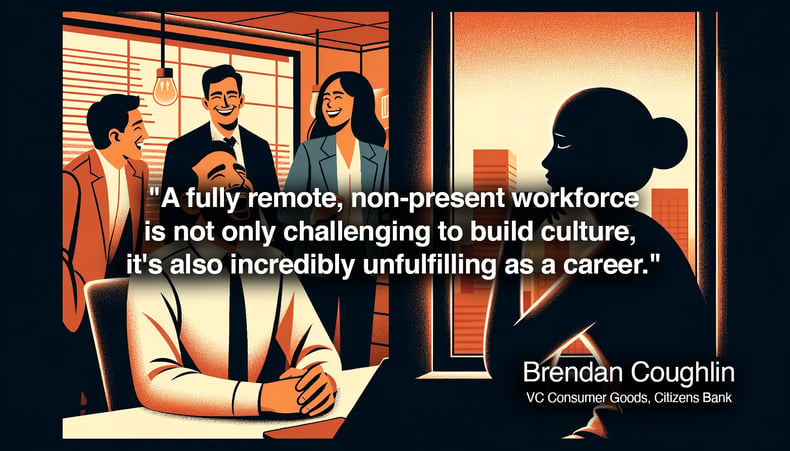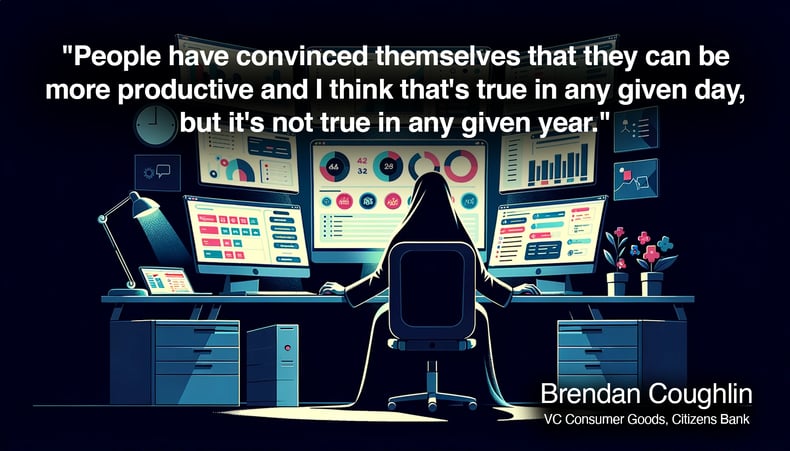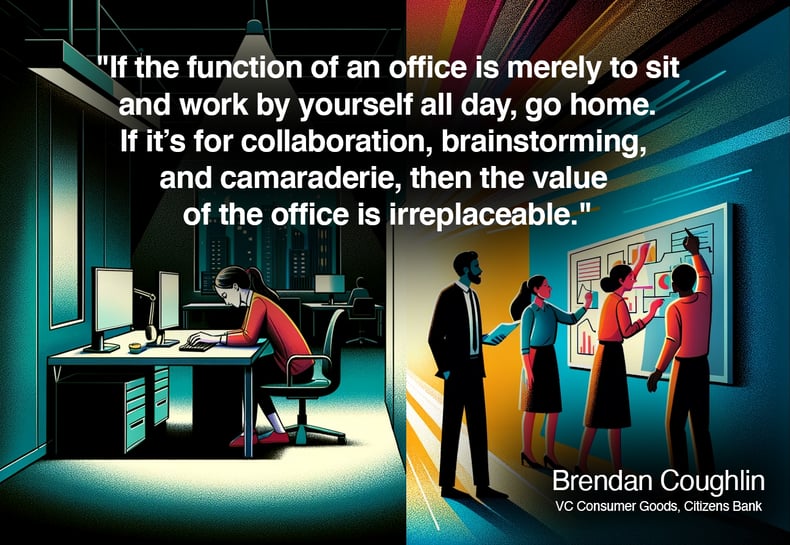
In today's remote workplace, many entrepreneurs face the significant challenge of fostering a cohesive and vibrant company culture in remote work settings. One of the most pressing pain points is the inherent difficulty of translating in-person interactions and office dynamics into a virtual environment. Without the organic conversations by the water cooler or spontaneous team lunches, building a unified culture can seem like an uphill battle. I recently had the privilege of hearing insights from the VC of Consumer Banking for Citizens Bank on this very topic. His perspective on leadership in a remote context was illuminating and underscored the importance of intentional efforts in cultivating culture. Here are four standout quotes that resonated deeply, followed by our reflections on addressing the intricacies of leadership and culture in a remote workplace.
1. Remote Work's Impact on Career Fulfillment

There's a richness in workplace interactions that can't be replicated on virtual platforms. Working from home may seem appealing, but there’s a deeper layer to consider: career fulfillment. Career fulfillment often arises from not just accomplishing tasks, but also from mentorship and shared experiences that are more prevalent in a physical work environment. Creating career fulfillment in a remote work position can be a challenge due to the lack of face-to-face interactions and traditional office environment perks. However, with some thoughtful approaches, one can foster a fulfilling remote work experience. Here's how:
- In-Person Gatherings: If feasible, organize occasional in-person meetings or team gatherings. This can strengthen team bonds and offer a break from the routine of remote work.
- Mentorship Programs: Pair remote workers with mentors to guide and support them in their career progression.
- Social Interaction: Organize virtual coffee breaks, happy hours, or team-building exercises. This will help workers feel connected and part of a community.
- Peer Recognition and Rewards: Celebrate achievements, no matter how big or small. A simple acknowledgment can go a long way in boosting morale. Virtual tools like Bonusly, is a peer-to-peer recognition platform that offers rewards and delivers them instantly.
- Health and Well-being Programs: Encourage your virtual team to set boundaries to prevent burnout. Offer online fitness classes, mental health resources, or wellness challenges to support employees' overall well-being.
2. The Illusion of Remote Productivity
 There's a misconception that remote workers are always more productive because of the flexibility and autonomy associated with working from home. In reality, remote workers can face numerous distractions, isolation, and potential burnout. To solve this illusion and genuinely enhance remote productivity, here are some tips companies can put in place to ensure that the productivity of their remote teams is real and sustainable, not just an illusion.
There's a misconception that remote workers are always more productive because of the flexibility and autonomy associated with working from home. In reality, remote workers can face numerous distractions, isolation, and potential burnout. To solve this illusion and genuinely enhance remote productivity, here are some tips companies can put in place to ensure that the productivity of their remote teams is real and sustainable, not just an illusion.
- Trust, but Verify: Clearly define roles, responsibilities, and tasks for each employee. This provides a concrete benchmark against which their productivity can be measured.
- Regular Check-ins: Schedule daily or weekly check-ins to discuss progress, challenges, and concerns. This helps in maintaining alignment with company goals and ensuring tasks are on track.
- Use Productivity Tools: As companies become more remote, integrating productivity monitoring tools for remote workers is ever more important. Tools like Hubsfaff allow companies to monitor their team's performance remotely. Implement project management tools like Trello, or ClickUp to manage projects and help teams stay organized and accountable to each other.
3. The 9-5 Model has Changed

With the fading traditional 9-5 model, there's a transformation in how we perceive work. As work-life boundaries blur and flexibility becomes the norm, it challenges the very fabric of conventional workplace hierarchies and norms. It’s essential to acknowledge this change and adapt to the emerging dynamics while retaining core cultural values. Here's a guide on how to address this transformation:
-
Re-evaluate Work Priorities and Policies: Start by understanding what tasks need consistent hours and which ones can be flexible. This assessment will help in redesigning job roles and responsibilities accordingly. Update company policies to reflect the new work model. This could include changes in overtime, availability expectations, and communication protocols.
-
Introduce Flexible Schedules: Recognize that not everyone is productive during the traditional 9-5 hours. Allow employees to choose their work hours, within limits, based on when they're most productive and the company's operational needs.
- Leaders Need to Reinforce Company Culture: Leaders should actively participate and model the new work behaviors and reinforce the company's core values. When employees see leaders adapting to and supporting the culture, they're more likely to embrace it. Organize virtual team-building events, workshops, or training sessions that reinforce the company's core values. This will help in keeping the culture intact even if the traditional work model changes.
-
Focus on Results, Not Hours: Consider measuring success by outcomes and the quality of work, instead of hours clocked. This will motivate employees to manage their time effectively.
-
Maintain Communication Channels: With varied schedules, it's crucial to have established communication channels. Tools like Slack, Microsoft Teams, or Zoom can help teams stay connected.
In essence, while the traditional 9-5 work model is evolving, the core cultural values of a company don't have to be compromised. By being proactive, adaptive, and understanding, companies can successfully navigate this transformation, aligning their operations with the modern realities of work.
4. World-Class Culture as a Benchmark

I've always felt that genuine connections are fostered through shared experiences and nuanced interactions that virtual settings often miss. It's a compelling reminder that while strategies and technologies evolve, the essence of a company—its culture—remains a pivotal determinant of its success. Here are some ways you can monitor the health of your culture.
-
Implement a Team Engagement Score: Measure how engaged employees are through one-on-ones and regular surveys. Consider using a Net Promoter Score (NPS) to gauge teams' likelihood to recommend the company as a great place to work. High engagement levels often correlate with a strong company culture.
-
Participation and Completion Rate: Track how many employees are attending training sessions on core values and their completion rates. Companies should also monitor the number of employees participating in team-building activities and their feedback on these events.
-
Monitor Core Values: Leaders should be transparent and communicate when a team member is demonstrating core values and when they are not. Consider using "+" for those who consistently demonstrate the company values. A "+/–" when they are inconsistent in demonstrating company values. Use "–" when team members violate the values. Monitoring instances where company core values are violated, can serve as a counter-metric to ensure the company stays on track and gets rid of bad apples.
- Leadership Trust Score: Leaders should be measured too. Send surveys to your teams to determine their level of trust in company leadership. Understanding how much your team can trust you can help leaders see gaps in their leadership.
When implementing these measurement tools, it's crucial to communicate their purpose to the entire organization, ensuring everyone understands that they're in place to enhance the company culture and not just as another performance measurement tool. Reviewing and adjusting these KPIs will ensure they remain relevant and aligned with the company's evolving cultural goals.
Conclusion: Balancing a Hybrid Model
 While collaboration can be done online, it's best if a company has a strong culture of people meeting face-to-face. A world-class culture is cultivated in close-knit communities, where proximity fosters deeper connections, trust, and shared purpose. The office becomes a beacon, the one place that brings people together. Proximity and genuine human interactions are irreplaceable, and as we navigate the evolving landscape, it's crucial to ensure that core values aren't left behind. The challenge ahead is to navigate the digital age while ensuring we don’t lose the human touch.
While collaboration can be done online, it's best if a company has a strong culture of people meeting face-to-face. A world-class culture is cultivated in close-knit communities, where proximity fosters deeper connections, trust, and shared purpose. The office becomes a beacon, the one place that brings people together. Proximity and genuine human interactions are irreplaceable, and as we navigate the evolving landscape, it's crucial to ensure that core values aren't left behind. The challenge ahead is to navigate the digital age while ensuring we don’t lose the human touch.
For more articles on leadership take a look at our leadership blogs or growth resources.










